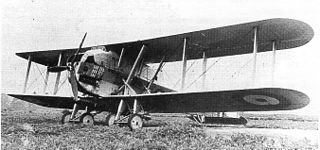Related Research Articles

The Hawker Harrier was an experimental biplane torpedo bomber aircraft built by Hawker Aircraft to a specification issued in the 1920s for the RAF.

The Bristol Bombay was a British troop transport aircraft adaptable for use as a medium bomber flown by the Royal Air Force (RAF) during the Second World War.

Between 1911 and 1914, the Royal Aircraft Factory used the F.E.2 designation for three quite different aircraft that shared only a common "Farman" pusher biplane layout.

The Armstrong Whitworth F.K.3 was a British two-seat general-purpose biplane built by Armstrong Whitworth Aircraft during the First World War. By the end of the war it was considered obsolete for combat.

The Avro 549 Aldershot was a British single-engined bomber aircraft built by Avro.

The Airco DH.1 was an early military biplane of typical "Farman" pattern flown by Britain's Royal Flying Corps during World War I. By the time the powerplant for which it was designed was sufficiently plentiful it was obsolete as an operational aircraft, and apart from a few examples sent to the Middle East it served as a trainer and Home Defence fighter.

The Martinsyde G.100 "Elephant" and the G.102 were British fighter bomber aircraft of the First World War built by Martinsyde. The type gained the name "Elephant" from its relatively large size and lack of manoeuvrability. The G.102 differed from the G.100 only in having a more powerful engine.

The Airco DH.11 was a British twin-engined biplane bomber which was designed to replace the earlier Airco DH.10 bomber. It was designed to use the unsuccessful ABC Dragonfly engine and was abandoned after the first prototype was built.

The Blackburn T.4 Cubaroo was a prototype British biplane torpedo bomber of the 1920s. Built by Blackburn Aircraft and intended to carry a large 21 in (533 mm) torpedo, the Cubaroo was one of the largest single-engined aircraft in the world at the time of its first flight.

The Airco DH.3 was a British bomber aircraft of the First World War. The DH.3 was designed in 1916 as a long-range day bomber by Geoffrey de Havilland, chief designer at the Aircraft Manufacturing Company. It was a large biplane with wide-span three-bay wings, slender fuselage, and a curved rudder. It was powered by two 120 hp (89 kW) Beardmore engines, mounted as pushers between the wings. In addition to tailskid landing gear, two wheels were placed beneath the nose to prevent bumping.

The Vickers Type 163 was a prototype British biplane bomber design of the 1930s, built by Vickers-Armstrong.

The Avro Type 557 Ava was a British twin-engined biplane torpedo bomber of the 1920s. It was developed by Avro to meet a requirement for a heavy torpedo bomber for the Royal Air Force but was unsuccessful, only two prototypes being built.
The Grahame-White Ganymede was a prototype British heavy night bomber intended to serve with the Royal Air Force in the First World War. A large, three-engined, twin-boom biplane, the sole prototype Ganymede did not fly until after the war had ended, and although an attempt was made to convert the aircraft to an airliner, it was unsuccessful.
The Boulton & Paul P.7 Bourges was a prototype British twin-engined biplane day bomber built by Boulton & Paul to replace the Airco DH.10. Despite demonstrating excellent performance and manoeuvrability, only three prototypes were built, post World War I cost cutting leading to the DH.10 not being replaced.
The Bristol Type 6 T.T.A was a British two-seat, twin-engine biplane, designed in 1915 as a defence fighter. Two prototypes were built, but the T.T.A. did not go into production.
The de Havilland DH.72 was a large British three-engined biplane bomber, designed as a Vickers Virginia replacement. It did not go into production.
The Vickers E.F.B.8 was a prototype British twin-engined fighter of the First World War. It was abandoned after only one aircraft was built, single-engined fighters being considered to have superior manoeuvrability.

The Curtiss C-1 Canada was a twin-engined bomber aircraft of the First World War which was designed by Curtiss of America to be built by their Canadian subsidiary for the British Royal Naval Air Service and Royal Flying Corps. Although large orders were placed, only twelve were built, the type being rejected in favour of more capable aircraft such as the Handley Page O/100.
The Sopwith Cobham was a British twin-engined triplane bomber aircraft designed and built by the Sopwith Aviation Company during the First World War. The only twin-engined aircraft built by Sopwith, the Cobham did not fly until after the end of the war, and was unsuccessful due to the failure of its engines, only three prototypes being built.

The Sopwith 2B2 Rhino was a British two-seat triplane bomber designed and built by Sopwith Aviation Company as a private venture. The Rhino was powered by a 230 hp (172 kW) Beardmore Halford Pullinger inline piston engine. Only two aircraft were built and the type did not enter production.
References
- Citations
- Bibliography
- Bruce, J. M. (1957). British Aeroplanes 1914–18. London: Putnam.
- Goodall, Michael H. (March 1973). "The Dyott Battleplane". Air Pictorial. pp. 106–109.
- Lewis, Peter (1980). The British Bomber Since 1914 (Third ed.). London: Putnam. ISBN 0-370-30265-6.
- Mason, Francis K. (1994). The British Bomber since 1914. London: Putnam. ISBN 0-85177-861-5.